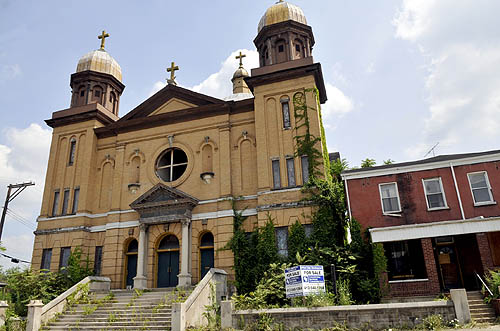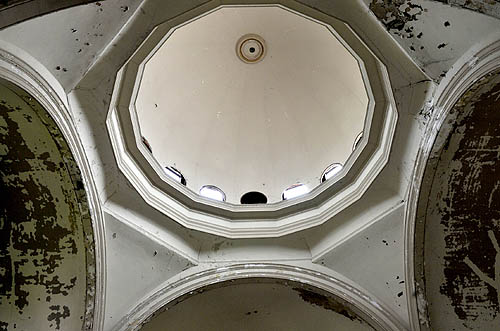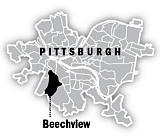
Category Archive: City Living
-
Buying Here: Larimer
Saturday, November 20, 2010By Gretchen McKay, Pittsburgh Post-GazetteOur Lady Help of Christians in Larimer was barely 5 years old when fire ripped through it in 1905, destroying the church at the corner of Meadow and Turrett streets. The Italian immigrants who had guided its construction in 1898, though, were a resolute bunch.
Within a year they’d rebuilt the Baroque-style structure, and until it closed in 1992, Help of Christians served as a center of Italian-American religious and social life, hosting not just Catholic Masses but everything from the annual celebration in honor of St. Agnello Abate to an array of sporting activities for neighborhood kids.
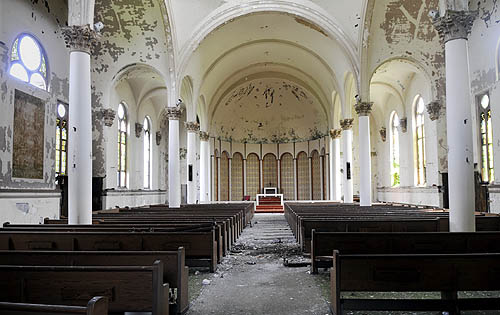
The ceiling and plaster walls have peeling paint at the former Our Lady of Help Christians church in Larimer. J. Monroe Butler II/Post-Gazette
Like many churches in the city, however, its parish aged and dwindled and was merged in the 1990s with five others to form St. Charles Lwanga parish in Lincoln-Lemington. In 1995, the Pittsburgh Catholic Diocese sold the church, which has a banquet hall in the lower level, and adjacent rectory to Heavenly Vision Ministries.
Three years ago, Heavenly Vision put 6513 Meadow St. back on the market, at first quietly through word of mouth, and then last year officially for $169,000 through Coldwell Banker Real Estate’s Fox Chapel office (www.pittsburghmoves.com; MLS No. 838378; 412-963-7655).
 Larimer
Larimer
At a glance- Website: www.city.pittsburgh.pa.us/district9/
- Size: .445 square miles
- Population: 2,602 (2000 census)
- School district: Pittsburgh Public, pghboe.net
- Enrollment: About 28,000
- Average 2010 SAT scores: (Peabody High School) 379 verbal; 410 math; 380 writing
- Taxes for a property assessed at $100,000 *: $2,870; City: $1,080 (10.8 mills); School district: $1,392 (13.92 mills); County: $398 (4.69 mills)
- Wage tax: 3 percent (1 percent to the city, 2 percent to the school district)
- Bet you didn’t know: Originally settled by Germans in the mid-1800s, Larimer was Pittsburgh’s “Little Italy” until the 1960s. It is named for railroad magnate and radical abolitionist General William Larimer, who built a manor home overlooking East Liberty along a path that would eventually become known as Larimer Avenue.
* Includes the Act 50 Homestead Exclusion, which reduces assessed market value by $15,000 for county taxes.Time has not been kind to Help of Christians, which could accommodate up to 1,000 worshippers in the nave and balcony in its heyday in the ’50s and ’60s. The amount of repairs necessary to breathe life back into the property are pretty extensive.
There is no glass in its long, arched windows and holes in the roof. The coved ceiling and plaster walls are peeling paint. Vandals have broken the pews and stolen the pipes from the organ. Carpeting is matted with dust, debris and pigeon feathers. The hand-painted frescoes that brightened the chancel are so badly faded and tarnished you almost can’t tell they were ever there. There’s no heat or water.
“People go in an ooh and aah over the architecture, but it’s a broken structure,” says Realtor Ted Harchick, who shares the “as-is” listing with Dan Boehler.
Adding insult to injury are the many thefts that have stripped the space of most everything of architectural significance. Only a handful of the dozens of original stained-glass windows remain. And it’s only because they’re too heavy to lift that looters also didn’t carry away the marble communion rails in the chancel.
Most heartbreaking is the massive circular window that crowned the front door. Somehow, the robbers managed to sneak the stained glass out of the wood framing in the stealth of night.
Vandals also have trashed the 6,000-square-foot rectory, which during Heavenly Vision Ministries’ tenure housed Family Options Foster Care, in addition to church offices. The property’s current market value is $256,400 ($172,900 for the church and $83,500 for the rectory). Taxes are in arrears on the rectory.
“It’s not for the faint of heart,” admits Mr. Harchick. “We need a risk-taker.”
On the plus side is its location in Larimer. Developments such as Bakery Square, a new “lifestyle center” in the old Nabisco plant on Penn Avenue, are helping to make one of Pittsburgh’s poorest neighborhoods attractive to national retailers and other businesses. UPMC, for instance, is planning to open a technology development center there by the end of the year, and Free People, a hip clothing boutique, follows on the heels of Anthropologie this winter. Next year, a $1.8 million, 14,500-square-foot vocational center funded by the Urban Redevelopment Authority and the Small Business Administration will open not far from the church on Meadow Street.
The Rev. Armenia Johnson, leader of Heavenly Vision Ministries, says she will be very careful in selecting a buyer for the old church.
“We want them to restore it into something that is beneficial and positive for this community,” she says.
In other words, if you’re thinking “brew house” or “night club,” it’s probably not going to fly.
Rev. Johnson, who is now associate pastor of St. James Baptist in Homewood, paid $100,000 the property in 1995. Although the Garfield native did her best to maintain the elegant building, she never had the funding she needed to properly maintain or improve it. So bit by bit, the once grand structure fell into terrible disrepair.
It’s a common fate for churches, which account for a growing number of real estate listings thanks to declining membership and consolidations. According to RealSTATS, a South Side-based real estate information company, 45 churches have changed hands in Allegheny and surrounding counties since January 2009, with sales prices ranging from $5,000 for Ambassador Baptist Church in Ross to $1.1 million for Christian Community Church in Adams.
Occasionally one will make the transition from place of worship to heavenly home. But given the high redevelopment costs, it often takes a grand idea — restaurant, performance hall, multi-unit condo development — and corporate investors to fill such a grand space. CVS, for example, bought the church in Adams. Most are purchased as-is by other religious organizations, or they languish on the market for years.
“You definitely don’t have as many players,” notes Tom Conroy of Howard Hanna Real Estate Services, who has sold so many churches for Hanna’s commercial division that he’s known as The Church Guy.
Mr. Conroy’s current listings include Harvest Baptist Church in New Kensington ($199,000; MLS No. QL102931); St. Michael Church ($250,000; MLS No. QL103962) in Munhall; and St. Mary Magdalene ($159,000; MLS No. QL103653) in Homestead.
Financing, zoning and parking all can be challenges. Many older churches were built in walkable residential areas that prohibit commercial enterprises. Former parishioners add to the difficulty. Even after religious artifacts have been removed and the building is just a building, some stay emotionally attached.
“Significant events take place there,” says Mr. Conroy. “Marriages, baptisms, funerals.”
-
City Will Return Lost Art to Public
Friday, November 19, 2010By Diana Nelson Jones, Pittsburgh Post-GazetteFive sculptures that were stored for years in a public works warehouse are being put back on pedestals four years after one artist’s persistent queries led to their discovery.
Thursday morning, a crew from Mangery & Sons hoisted Peter Calaboyias’ stainless steel sculpture “Five Factors” into place on a concrete slab behind the baseball field in Mellon Park, Shadyside.
Standing beside one of the six-sided skewed cylinders, he beamed and said seeing it in public was a thrill “after all these years.”
“Five Factors” was one of four sculptures chosen in a 1971 public art competition and placed atop the garage at the Squirrel Hill branch of the Carnegie Library. They were among the first contemporary sculptures to be displayed as public art in the city. At the time, the city required that 1 percent of the construction budget for a public building be spent on art.
Thomas Morandi, Edward Bordas and Jim Myford were the other artists whose works were chosen.
Years ago, the sculptures were removed, either for repair or to accommodate changes in use of space. Mr. Calaboyias thought his sculpture had been stolen and sold for scrap, he said.
Library officials said the works had been sent to a restoration company in the 1990s. But at some time after that, the public works department retrieved the works when the company went bankrupt and stashed them in a warehouse under the 62nd Street Bridge.
They stayed there until 2006, when Councilman William Peduto’s staff learned about the sculpture and contacted Mr. Calaboyias.
The artist, who had raced to the warehouse to make the identification, said it was both distressing and exciting to see them.
“Five Factors” was inspired by ancient Greek stelae, or cylindrical stone markers that were inscribed with words or carvings, he said.
Half of a Richard King Mellon Foundation grant of $300,000 was used to restore and relocate the sculptures. The fifth was the work of Aaronel deRoy Gruber. It was originally on the portico of the City-County Building, then on the site where the David L. Lawrence Convention Center is now. It was stored with the other four.
Morton Brown, public art manager for the city, said the five pieces were in “the most dire need” of conservatorship among the city’s collection. Three went to the McKay Lodge Conservation Lab in Ohio. Mr. Myford and Mr. Calaboyias did their own repairs; in fact, Mr. Calaboyias’ is an exact replica of the original, which “had too many dents to be pounded out to save,” he said.
The Bordas piece has to hang on a wall, said Mr. Brown. Its new location has yet to be decided.
“I’m trying to find a city-owned facility that has an architectural style” that’s the right fit for “two abstract, elongated triangles welded together and painted red. Really quite beautiful. But I haven’t found the right place yet.”
The sculpture is under 200 pounds, he said.
Mr. Myford’s work — two elongated rectangular forms angled like fingers aloft — was installed two months ago in Grandview Park in Mount Washington, just above the historic stone steps off Bailey Avenue.
Mr. Morandi’s and Ms. Gruber’s works will be installed in Mellon Park.
With the rest of the grant, Mr. Brown and the Greater Pittsburgh Arts Council’s Office of Public Art will determine which pieces should next be restored, weighing costs, deterioration, visibility and the prominence of the artist, he said.
“We have 110 pieces in the collection and we have about 21” identified as most in need, he said.
“If we can get five more done next year, then we will leverage money for the others.”
-
T & T Hardware Closing After 74 Years
Friday, November 19, 2010By Emily Gibb, Pittsburgh Post-Gazette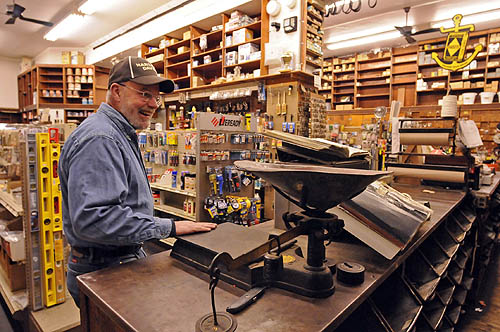
Manager Mark McNally is winding down business at T & T Hardware, a fixture at 2114 East Carson St. on the South Side since 1936. Owned by the Tumas family since its founding, the store has found it impossible to compete with big-box retailers. The scale, which has weighed countless nails and screws for sale by the pound, will remain with the Tumas family. Everything else will be marked down 50 percent Monday morning. Bob Donaldson/Post-Gazette
Pull open the solid wood door with its weathered red paint, walk into T & T Hardware Co. Inc. on the South Side and it’s a bit like stepping back in time.
Wooden shelves line the walls, some all the way to the ceiling, along with rows and rows of little wooden drawers full of screws, nuts and bolts behind a wooden counter along the back. Power tools almost seem out of place in their wood and glass displays.
But next week, after fighting off hard times the last few years, the hardware store fixture on Carson Street begins the process to shut its doors for good.
The “mom and pop” store has too much remaining inventory to liquidate or auction off yet, so beginning Monday, everything is 50 percent off the original price, said manager Mark McNally, 55, of Mount Washington.
They are waiting to see how long it takes to sell most of their inventory to set an exact closing date. This week, they’re just trying to get everything out on the shelves.
Stanley Tumas opened T & T Hardware in 1936. After he retired in the late 1980s, his son, Michael Tumas, took over ownership of the store.
It has stayed in the same spot for the last 74 years, expanding to the side and to the back as the years went on. It was a work in progress until the ’80s, Mr. McNally said.
He says they’ve always had a reputation as the place to go for “odd stuff that no one else has,” like specific plumbing parts, nuts, bolts or screws.
Since he began working at a hardware store in Mount Washington as a teenager and then managing T & T Hardware for the last 15 years, Mr. McNally has seen many changes in the business.
Part of the challenge comes from “big box” stores, like Home Depot. “They’re key why these stores are going,” he said.
Competing with a Lowe’s only five miles away has been difficult.
“It’s just too close. I can show you on my books when they opened,” he said.
Besides competing with large chains, they are competing with the economy as well.
A lot of their business used to come from commercial contractors, but if the contractors don’t have jobs to do, they won’t be coming the hardware store for supplies.
On top of the struggling economy, the South Side is a changing neighborhood.
“For a store like this, the neighborhood has to support it,” he said.
But most people in the neighborhood now rent their houses. Generally, renters aren’t in need of hardware supplies when they can just call their landlord to take care of things.
Saturday used to be the busiest day of the week for a hardware store, Mr. McNally said. Customers who had the day off work would buy their home improvement supplies in the morning. If they were having problems, they would return around noon. If they were really having problems, they would be back again around 3 p.m., Mr. McNally said.
But last year, he started closing on Saturdays — they didn’t have enough weekend business to make it worthwhile anymore.
At one time there were four or five hardware stores just on the South Side, but, he says, “times change. I understand that.”
As Mr. McNally starts a new phase, he has to say goodbye to more than a store and a building.
“The people, without a doubt — that’s what I’m going to miss the most. After 15 years you make good, good friends,” he said.
-
South Side Hardware Store Ends 74-Year Run
By Craig Smith, PITTSBURGH TRIBUNE-REVIEW
Wednesday, November 17, 2010Pittsburgh’s South Side was a different neighborhood in 1936 when Stanley J. Tumas scraped together $800 to open his T&T Hardware store on East Carson Street.
“It was an old ethnic neighborhood. People took pride in that neighborhood,” said his son, Mike Tumas, 59, of Coudersport, Potter County, who has decided to close the store his father started 74 years ago.
The hardware store became a staple of the neighborhood anchored by the nearby J&L Steel mill, he said.
“Guys would get laid off. Their wives would say, ‘You’re painting the house,’ ” Mike Tumas said. “We did well. We did a good business.”
And the business grew over the years. It doubled in size when Stanley Tumas knocked down a wall separating the building.
Father and son worked hard.
“You spent vacations, days off, working at the store,” Mike Tumas said. “That was our life.”
But T&T and other neighborhood hardware stores found it hard to compete with big box chain stores and a changing market. Modernization — fax machines and computers — proved difficult for veteran shopkeepers used to sales receipt books with 50 pages in them, Mike Tumas said.
“My dad’s idea of a fax machine was to hand you a receipt and say, ‘Run this down the corner,’ ” Mike Tumas said.
Three people will lose their jobs when T&T closes before the end of the year. Tumas said he tried to sell the business but found no takers. He plans to sell the building.
“A lot of commercial accounts told me they were leaving Pittsburgh and Allegheny County because of the taxes,” he said. “What commercial businesses are on the South Side anymore?”
Hardware stores used to dot the area — three in Mt. Washington, two in Allentown, four in the South Side.
“We ran longer than most,” said Mark McNally, T&T’s manager.
It was an uphill run.
Home Depot said its sales during the third quarter totaled $16.6 billion, a 1.4 percent increase from the third quarter of fiscal 2009. Lowe’s Cos. Inc. reported sales for the quarter increased 1.9 percent to $11.6 billion, up from $11.4 billion in the third quarter of 2009.
“It’s hard to fight the big guys — they are so big,” said Duquesne University marketing professor Audrey Guskey. “These are family owned, the money stayed here, and the owners poured their hearts and souls into the business.”
The inventory at T&T Hardware, kept in homemade wooden drawers and metal bins, will be liquidated before the store closes, Tumas said.
-
Buying Here: Beechview
Saturday, November 13, 2010By Kevin Kirkland, Pittsburgh Post-Gazette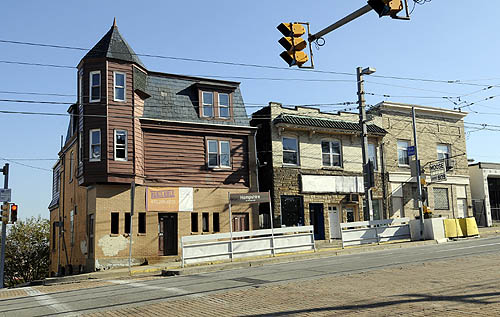
The city's Urban Redevelopment Authority has foreclosed and put on the market four buildings -- 1600, 1601, 1602 and 1619 Broadway Ave. == with hopes of enticing developers to invest in this business district and begin its turnaround. Larry Roberts/Post-Gazette
The panoramic views of the South Hills from the third-floor balcony of 1600 Broadway Ave. are a sight for sore eyes — especially if you live in Beechview.
For the last five years, residents of that city neighborhood and riders on the LRT have had to look at mostly shuttered storefronts on Broadway that were bought — then abandoned — by investor Bernardo Katz. The city’s Urban Redevelopment Authority has foreclosed and put on the market four buildings — 1600, 1601, 1602 and 1619 Broadway Ave. — with hopes of enticing developers to invest in this business district and begin its turnaround.
“Beechview is a very cool neighborhood,” said URA Director Rob Stephany. “I think its proximity to the T makes it interesting.”
Mr. Katz defaulted on millions of dollars worth of mortgages and more than $700,000 in loans from the URA that he used to buy these and other commercial properties in Beechview, Oakland and Mt. Lebanon. He fled to his native Brazil in December 2007 and was charged in absentia last year with federal wire and mortgage fraud.
Although most of the buildings were left to deteriorate, Mr Katz worked on the exterior and interior of the first floor of 1600 Broadway and briefly opened a Mexican restaurant there. The largest of the four, it’s now priced at $194,800. The newer storefront reflects its early 1900s construction while the second and third floors have a total of five apartments and another in the basement, with walkout access on Hampshire Avenue. The URA gutted the apartments to the plaster lathe, removing asbestos and all mechanical systems.
“That’s the way developers want it,” said Dave Majcher, URA senior construction coordinator.
Also gutted was the adjoining 1602 Broadway ($43,000), a former bar that has a new roof and a rickety rear addition that the URA says should be removed. Across the street is 1601 Broadway ($130,000), another former bar with a turret and a few architectural details that survived previous remodels — an original staircase and a columned fireplace mantel on the second floor. The views from its second- and third-floor windows are classic Pittsburgh, with small houses clustered along hilly streets.
A half-dozen storefronts separate 1601 from 1619 Broadway ($70,000), a small former video store with an intact three-bedroom apartment behind.
“It’s perfect for a small business owner,” Mr. Stephany said. “Someone could be in at a reasonable cost.”
The other three buildings, however, are suitable only for developers, he said. A feasibility study the URA commissioned last year estimated exterior and interior renovation costs at $588,799 for 1600 Broadway, $409,586 for 1601 and $457,866 for 1602.
“These are probably $600,000 events,” Mr. Stephany said.
Even with façade grants and streetscape loans, buyers would still be looking at construction loans of at least $400,000 for each building. Everything is not bleak, however. IGA plans to reopen the shuttered Foodland next to 1602 Broadway, and brothers Kevin and Adam Costa have purchased 1603 Broadway to open their Crested Duck Charcuterie, “an artisanal meat market.” At least initially, the apartments may be the hotter part of the properties.
“I do think the first floors will come,” Mr. Stephany said. “I’m not sure they will come first.”
Susheela Nemani-Stanger, a URA project development specialist, believes loft apartments would suit college students who appreciate their proximity to mass transit.
“They would be perfect for students from the Art Institute or Culinary Institute,” she said.
For more information on 1600, 1601, 1602 or 1619 Broadway Ave., Beechview, call 412-255-6612 or go to www.buyintheburgh.com.
SALES SNAPSHOT16TH WARD/SOUTH SIDE 2009 2010 SALES 138 147 MEDIAN PRICE $45,000 $62,000 HIGHEST PRICE $505,000 $380,000 17TH WARD/SOUTH SIDE 2009 2010 SALES 143 134 MEDIAN PRICE $121,250 $137,000 HIGHEST PRICE $800,000 $595,000 18TH WARD/MOUNT WASHINGTON 2009 2010 SALES 141 137 MEDIAN PRICE $12,000 $13,000 HIGHEST PRICE $750,000 $669,000 19TH WARD/BROOKLINE 2009 2010 SALES 462 467 MEDIAN PRICE $65,000 $68,000 HIGHEST PRICE $625,000 $465,000 20TH WARD/WEST END 2009 2010 SALES 245 208 MEDIAN PRICE $33,000 $31,800 HIGHEST PRICE $200,000 $255,000 29TH WARD/CARRICK 2009 2010 SALES 121 148 MEDIAN PRICE $49,000 $45,000 HIGHEST PRICE $133,000 $147,500 30TH WARD/KNOXVILLE 2009 2010 SALES 58 54 MEDIAN PRICE $9,900 $10,100 HIGHEST PRICE $77,000 $55,000 31ST WARD/LINCOLN PLACE 2009 2010 SALES 45 72 MEDIAN PRICE $66,000 $63,000 HIGHEST PRICE $147,400 $335,000 32ND WARD/OVERBROOK 2009 2010 SALES 115 119 MEDIAN PRICE $67,000 $73,000 HIGHEST PRICE $226,000 $229,550 MOUNT OLIVER 2009 2010 SALES 58 55 MEDIAN PRICE $16,201 $20,000 HIGHEST PRICE $79,500 $76,500 WEST HOMESTEAD 2009 2010 SALES 17 23 MEDIAN PRICE $43,100 $22,000 HIGHEST PRICE $169,900 $125,000 Beechview
At a glance- Website: www.beechview.org
- Size: 1.46 square miles
- Population: 8,772 (2000 census)
- School district: Pittsburgh Public (pghboe.net)
- Enrollment: 25,326
- Average 2010 SAT scores: 425 verbal, 446 math, 423 writing
- Taxes on a property assessed at 100,000 : $2,870; City: $1,080 (10.8 mills), school district: $1,392 (13.92 mills), county: $398 (4.69 mills), wage tax: 3 percent (1 percent to the city, 2 percent to the school district)
- Claim to fame: Named for the many beech trees found on its hillsides, Beechview (incorporated as a borough in 1905 and annexed to the city four years later) has the steepest street in hilly Pittsburgh, and quite possibly the world. Canton Street has a grade of 37 percent — that is, it rises 37 feet per 100 feet of run. So steep is the bottom half, that residents aren’t supposed to drive down it.
-
Schwartz Market Alive and…Well, Hoping to Sell
Wednesday, November 10, 2010 08:00 AMStaff Blogs by the Pittsburgh Post-Gazette
Written by Diana Nelson Jones
Since I reported in May that Schwartz Market had a buyer, shoppers have assumed that the little store on East Carson Street had gone out of business.
Not so! Schwartz Market at 1317 E. Carson, is alive and wants you to know it will remain alive until a buyer actually comes through. An IGA grocer had signed a letter of intent in May but backed out of the deal because the building needed upgrades that the building owners have not made.
The building is owned by family of the founding grocers, who once operated six Schwartz Markets in the city. The South Side market, which is on Facebook, has been in operation since the 1920s.
Marty and Audrey Dorfner and Rick and Donna Stanton bought the business in 1985 and have operated it continuously since.
“My goal is to retire after 54 years in this [grocery] business,” said Marty, who has another grocer showing interest in the store.
Until then, said Donna, “We will be here because we want the neighborhood to be served.”
They are gearing up to meet your holidays needs with the kielbasa and sausages for which they are known.
My article was based on information that made the deal appear to be a sure thing. A lot of articles in the paper are anticipatory, such as economic development groundbreakings on ground that three years later have yet to see another shovel.
It’s one thing when there’s nothing there anyway; it’s another when a business suffers as a result. Our city neighborhoods need small retailers; remember to support them in these lean times.
-
Historic Pittsburgh Home Bears Benign Swastika
By Bob Bauder
PITTSBURGH TRIBUNE-REVIEW
Sunday, October 31, 2010
Thelma J. Smith's home on Andover Terrace in the Upper Hill District bears a swastika in concrete above the entrance. Before fascism, the swastika was viewed as a good-luck symbol. Justin Merriman | Tribune-Review
Thelma J. Smith and her late husband faced a moral dilemma nearly 30 years ago: As black Americans, they had to decide whether they wanted a universal symbol of hate to remain imprinted on the front of their historic Hill District home.
The swastika was covered for decades by previous owners, and no one in the neighborhood, not even the Smiths until after they bought the house, knew it was there.
Thelma Smith thought of the Jewish neighbors, Holocaust survivors with concentration camp numbers tattooed on their arms.
What would they say? she asked herself.
More importantly, what would people in the community say?
The Smiths researched the subject. What they found, combined with what they knew about the house, swayed them.
The swastika predates Nazis by thousands of years. Before fascism, it was viewed as a good-luck symbol. The one in question was an original feature on a house that was then about 69 years old, the second-oldest home on an old street.
Smith, 72, had to explain all of that to the Jewish neighbors, who came to her upset but later agreed the swastika in this case is benign. It differs from the Nazi symbol in that it is not positioned at an angle.
“I just felt it was important historically to keep it,” Smith said.

A photo from 1912 shows the builder (Lindermer at far right) of Smith's home, which was built in 1912 for Herman S. Davis, who christened his home "Swastika." Justin Merriman | Tribune-Review
The house on Andover Place was built in 1912 for Herman S. Davis, who christened his new home “Swastika,” according to a photograph album that Smith inherited from previous owners and the March 1913 issue of Concrete-Cement Age magazine, which featured a story on the house.
Davis, whom Concrete-Cement Age identifies as a consulting engineer and astronomer, had his house built of poured concrete, a new architectural technique at the turn of the last century. He had the swastika, which Thelma Smith estimated is two feet square, imprinted in a prominent location on an exterior wall facing the street. Nobody knows why.
The house has 13 rooms and 48 windows. It is the only house in the region known to have a swastika as a design feature, according to representatives of Pittsburgh History & Landmarks Foundation.
Thelma Smith said the swastika was covered by wood when they bought the house in 1976. About 1981, they had the concrete cleaned and the wood removed.
Ever since, the house has been a conversation piece and curiosity for people traveling the narrow, tree-lined street. The house is technically in the Upper Hill, but it’s on the last street before Schenley Farms Historic District. It seems secluded with its large trees, empty lots on either side and a steep hill in back rising about 60 feet to Dakota Street.
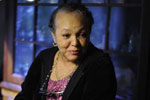
"I just felt it was important historically to keep it," Thelma J. Smith said of the swastika imprinted on her home. Justin Merriman | Tribune-Review
Numerous people stopped over the years to ask Smith and her family about the swastika. Cars slow down as they pass. Smith said police officers patrolling at night have shined spotlights on the swastika, presumably for new officers to see.
The family doesn’t mind the attention, but an event in May was a bit much. Somebody came in the middle of the night and attempted to cover the swastika with cement. Smith’s youngest son, Lee, noticed it and found imprints from a ladder in the yard.
His mother, who didn’t hear anything that night — probably because of the thick concrete walls — suspects a student prank. The University of Pittsburgh campus is just down the street. She said the kids probably were scared away before completing the job, which would explain why the swastika was partially filled in.
“They needed to be scared if I would have caught them,” said Lee Smith, 35, a Pittsburgh City Football League most valuable player for Schenley High during the 1990s and still in good shape.
He said a run-in with his father, Donald L. Smith, who died in September, would have been worse. In his younger days, Donald “Toro” Smith was a professional heavyweight boxer, who once fought Joe Frazier before Frazier became world champion.
The family cleaned out the cement without damage to the swastika.
There it remains for all to see, just as Herman S. Davis intended. And there it will stay, as far as Lee Smith is concerned.
Smith intends to buy the house in December from his mother. He said she can live there with him for the rest of her life. That suits his mother just fine.
“I always loved this street,” she said. “It’s country living in the city.”
-
Historic Designation Urged for Rest of Fineview Incline
By Tony LaRussa
PITTSBURGH TRIBUNE-REVIEW
Thursday, November 4, 2010
Bill Weis of Fineview walks Wednesday along the old wall that remains of the old Nunnery Hill Incline, which ran from 1887-89. Jasmine Goldband | Tribune-Review
As local historic landmarks go, the red-brick building and soot-streaked stone retaining wall that runs several hundred yards along Henderson Street in the North Side give little indication of their importance to Pittsburgh’s past.
Trees, shrubs and weeds have pushed their way through joints of the wall’s cut sandstone blocks, and sections lean precariously under the weight of the hillside rising above.
The walls and building along Federal Street are remnants of an incline that curved 70 degrees and ferried riders up and down the hillside between old Allegheny City and Nunnery Hill. The neighborhood perched on the hill behind Allegheny General Hospital was named for Flemish nuns who ran a school for girls there in the 1830s. It became Fineview.
“What’s left of the incline, which ran from 1887 to 1899, is a part of Fineview’s history that’s worth saving,” said Ed Lewis, director of Fineview Citizens Council. “We consider this a community asset that can be utilized in our long-range plan to create an inviting gateway to the neighborhood.”
On Wednesday, the city’s Historic Review Commission agreed.
In a 4-2 vote, the commission recommended that Pittsburgh City Council designate the structures as historic landmarks. Commissioners Linda McClellan and John Jennings voted against the nomination.
The incline was designed by prominent civil engineer Samuel Diescher, who designed the Duquesne Incline and the machinery for the Ferris wheel.
The building at the corner of Federal and Henderson was the incline’s base station but was not part of the original petition seeking historic preservation. Commissioners thought it was important to preserve the structure and the wall.
The building’s owner, Jonathan Shepherd, does not have to agree to a historic preservation designation for the process to proceed. He could not be reached.
“In the long run, I think the historic designation will be a benefit to the community and the owner of the property, especially with all the development that’s occurring along Federal Street,” said Walt Spak, vice president of the citizens council.
“And if there are any ways we can help the owner by obtaining grants or whatever is available to make improvements, we’ll be behind him,” he said.
A historic designation means property owners must obtain commission approval before making changes to the exterior.
Bill Weis, who grew up in Fineview and is a citizens council board member, said preserving the structures is a “big first step.”
“When we were kids, we used to play up where the tracks were located,” said Weis, 63. “It was deteriorating then and has only gotten worse. So if we’re going to save it, now is the time.”

